A big pan of winter comfort food made of tender cabbage with squares of pasta, onions and mushrooms. Traditional Polish łazanki is what happens when Italian cuisine goes to Eastern Europe. Think of it like Stroganoff's cousin from the Italian side of the family.
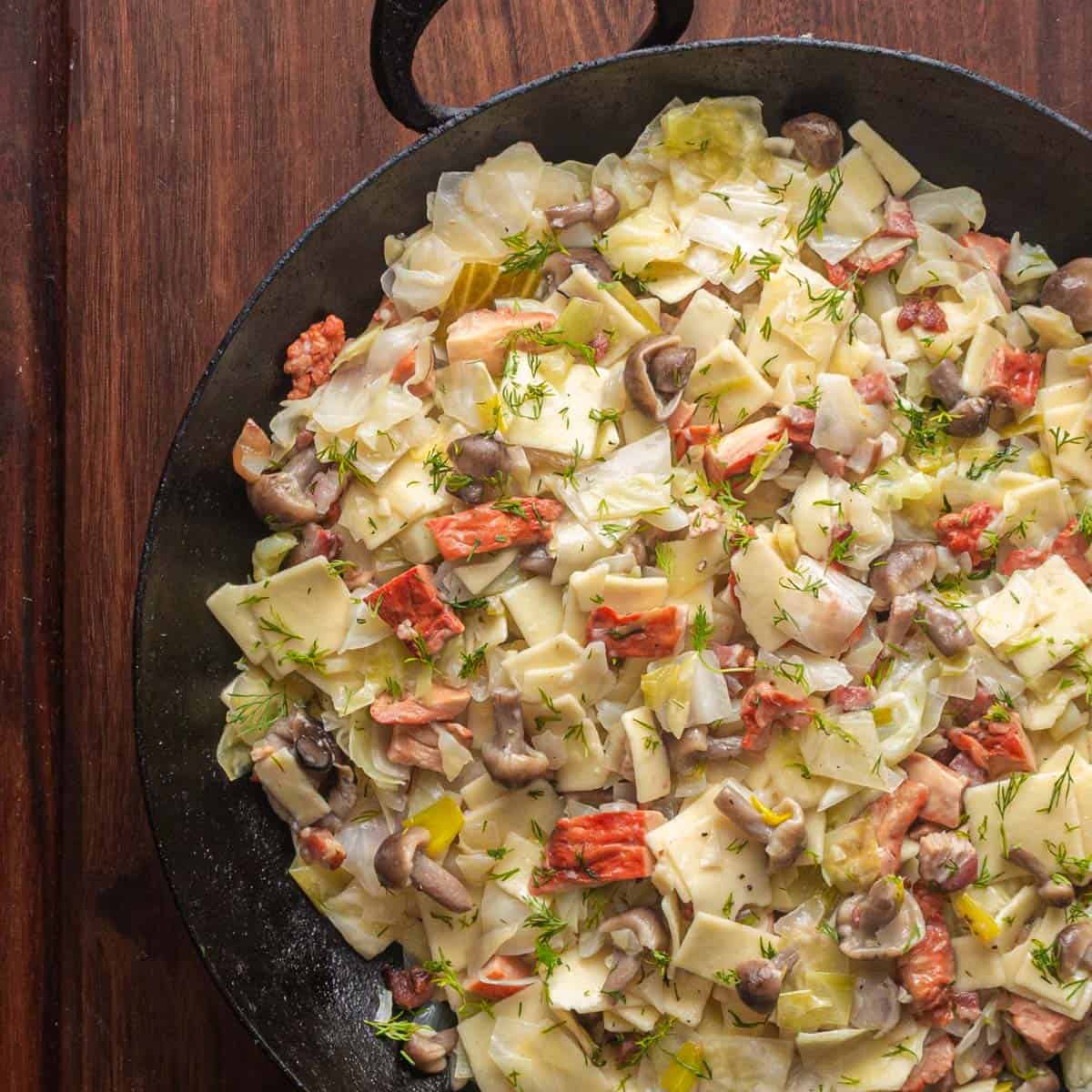
Lazanki with chicken of the woods mushrooms and honey mushrooms. Hen of the woods would be great too.
I have to mention there's also Slovak, Hungarian, German, Belarusian, and Ukrainian variations. Today I'll cover the basics and background of the dish, as well as some different ways you might make it.
History
According to legend, in the 16th century, Queen Bona Sforza married King Sigismund, making her the Queen of Poland and Duchess of Lithuania.
The queen brought her court cooks from Milan. With them came Italian ingredients and cooking techniques that married with the cuisine of the region, creating fusion dishes.
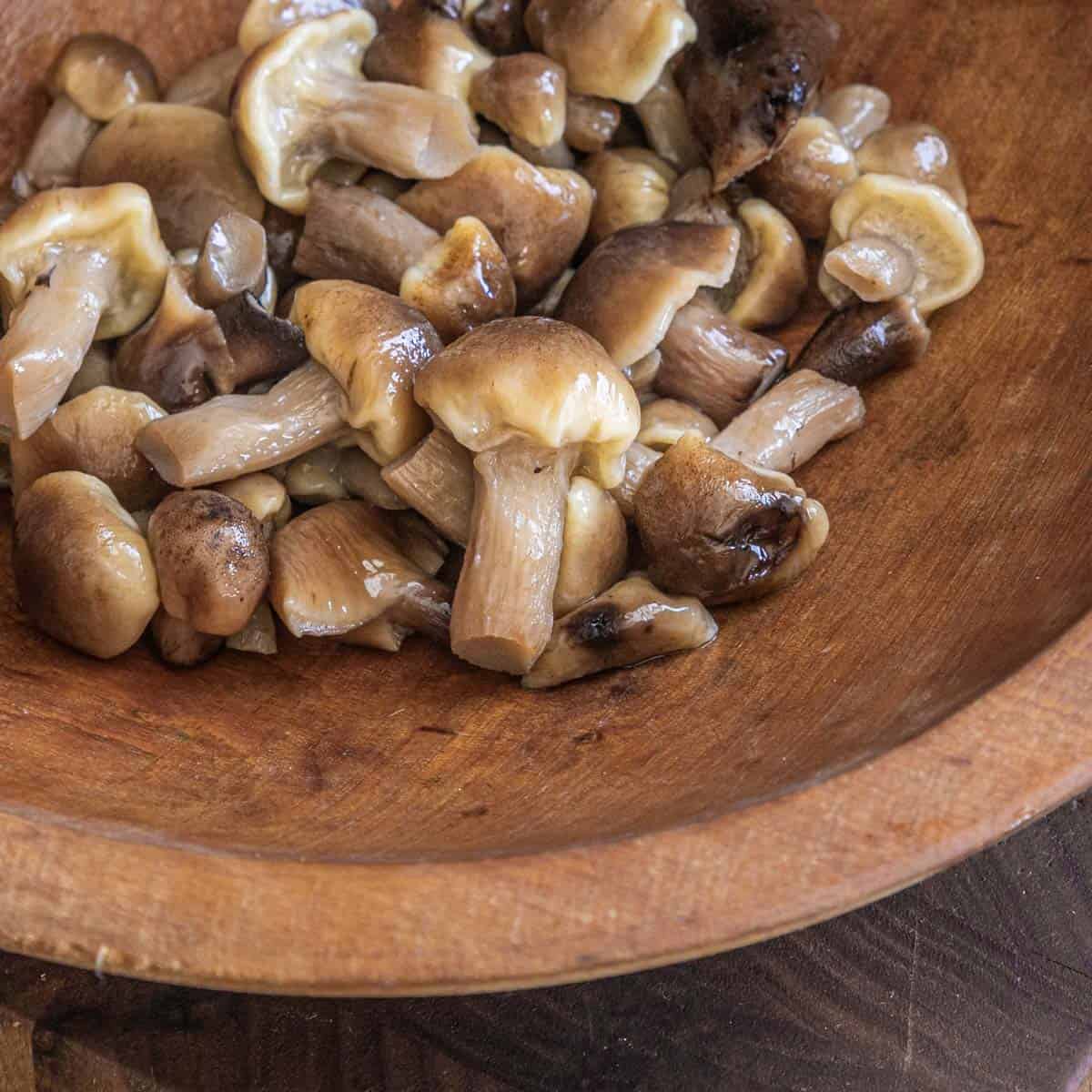
Polish Lasagne
The word lazanki is directly related to the word lasagna, and original versions were layered and baked. Wazanki is a synonym. Like lasagne, the original lazanki are square or rectangular homemade noodles.
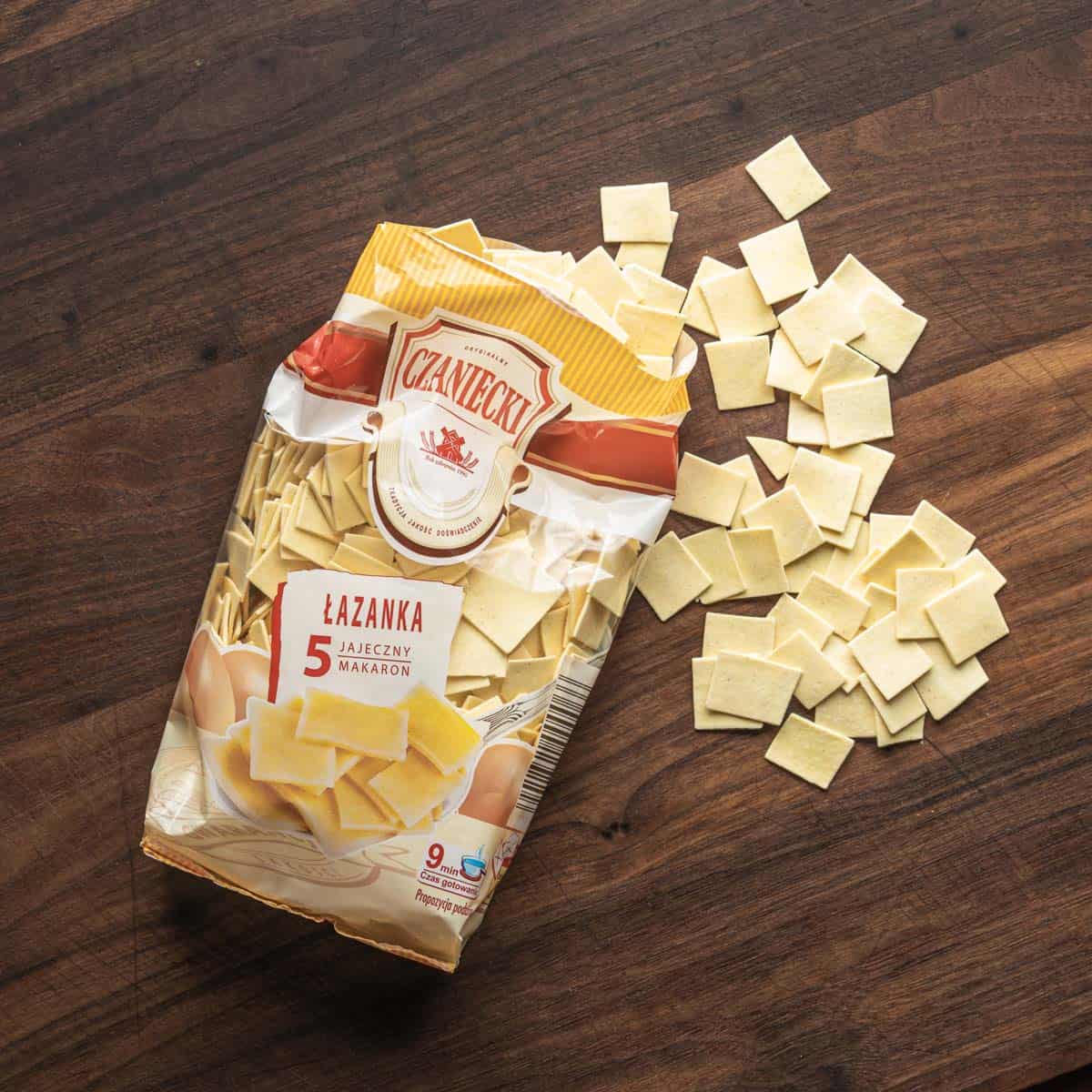
One historical difference between the two pastas is that lazanki were often made with buckwheat flour. Buckwheat is also used in other Northen Italian dishes like the buckwheat pasta of Fruili in Northern Italy.
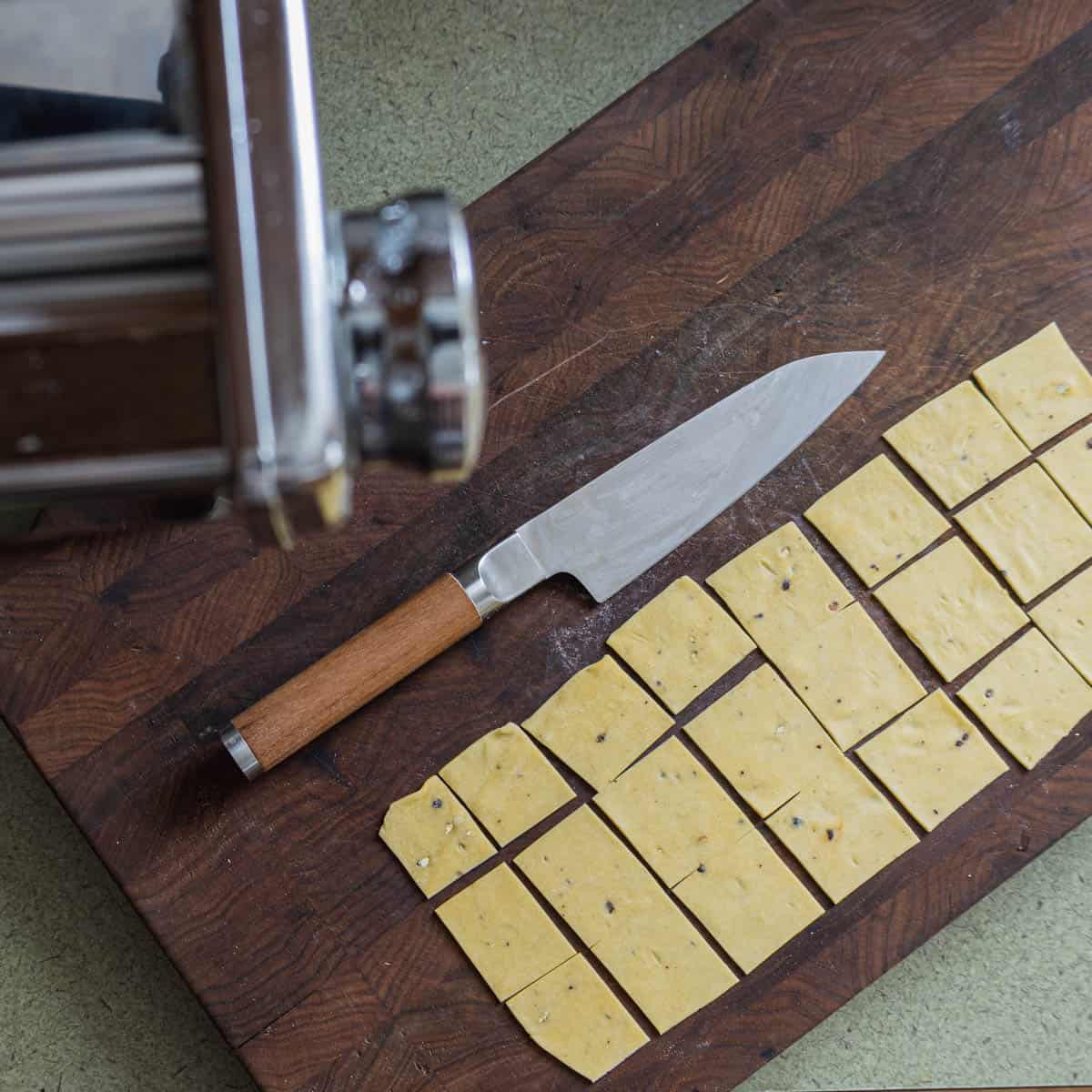
Haluski vs Lazanki
Americans may know lazanki's cousin called Haluski (fried cabbage with pasta). They're similar, but halusky may not contain mushrooms and has evolved to use egg noodles instead of the square lazanka. Some people I spoke to insisted it was Czech-not Polish, while others disagreed.
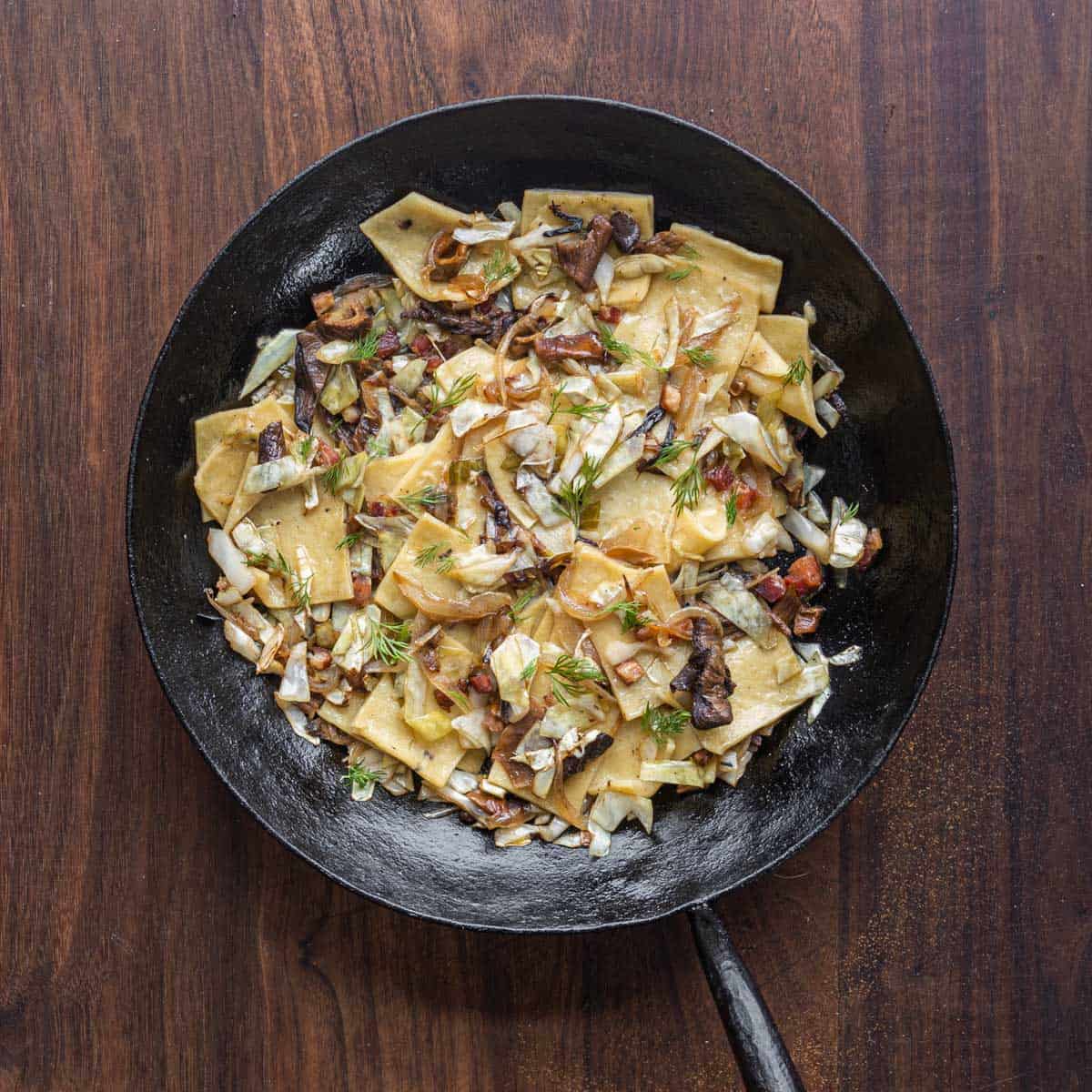
Haluski is a simple, one-pan dish where all ingredients are fried together before adding the pasta. Ukranian galushki, Polish kluski and kopytka are similar, but made with dumplings. If this dish is sounding good so far, make sure to bookmark Buckwheat Kasha with Wild Mushrooms and Onions, too.
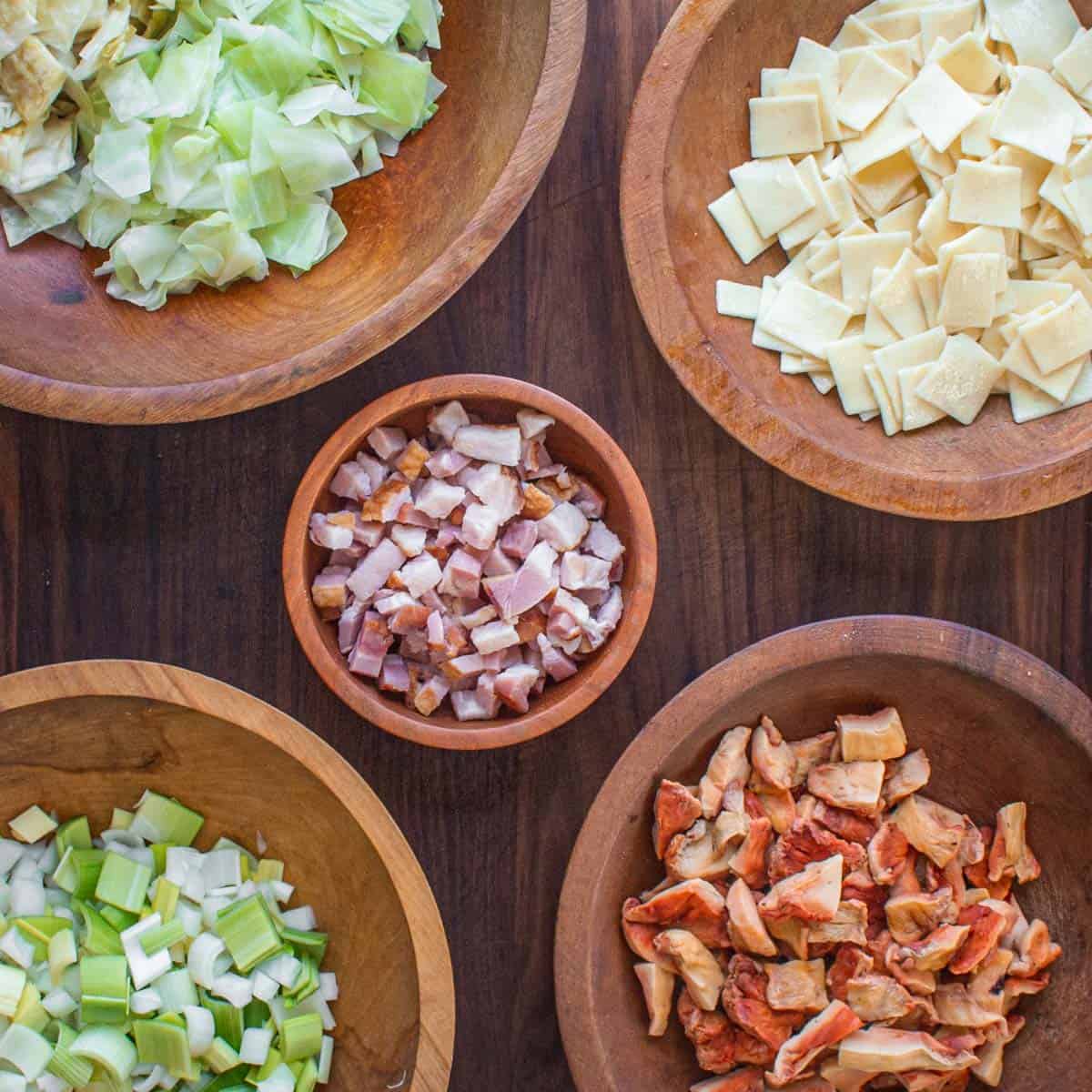
Cabbage and Sauerkraut
The ancestral dish was made using winter staples like sauerkraut, dried mushrooms, smoked sausages and other cured meats. Similar, again to cuisine from the Italian Alps where Eastern European flavors blend with Italian cuisine.
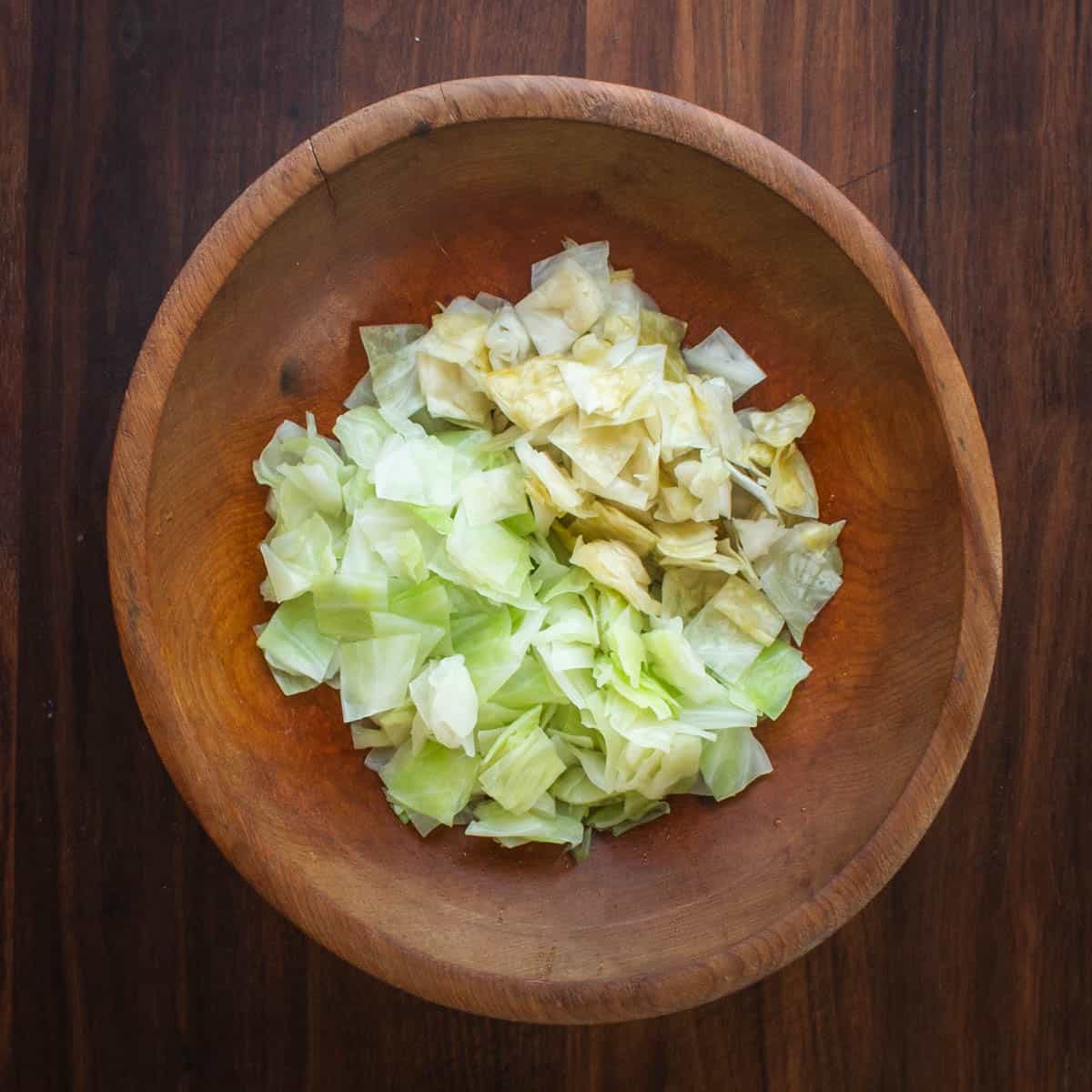
Modern American versions don't typically use sauerkraut. In a nod to tradition, I sometimes use a blend of both sour cabbage and chopped cabbage. You could also use Fermented Turnips (Sauerruben).
Variations
There's a lot of different ways this dish is made. The pasta can also be served in soup for Christmas with mushrooms or fish. Or it can be mixed with Twarog, a type of quark or curd cheese. I suspect twarog is mistranslated as cottage cheese in modern American recipes.
Haluski-Style
In this quick version the cabbage, onions, and mushrooms are fried in lard or bacon grease and garnished with sour cream. This is demonstrated in the video.
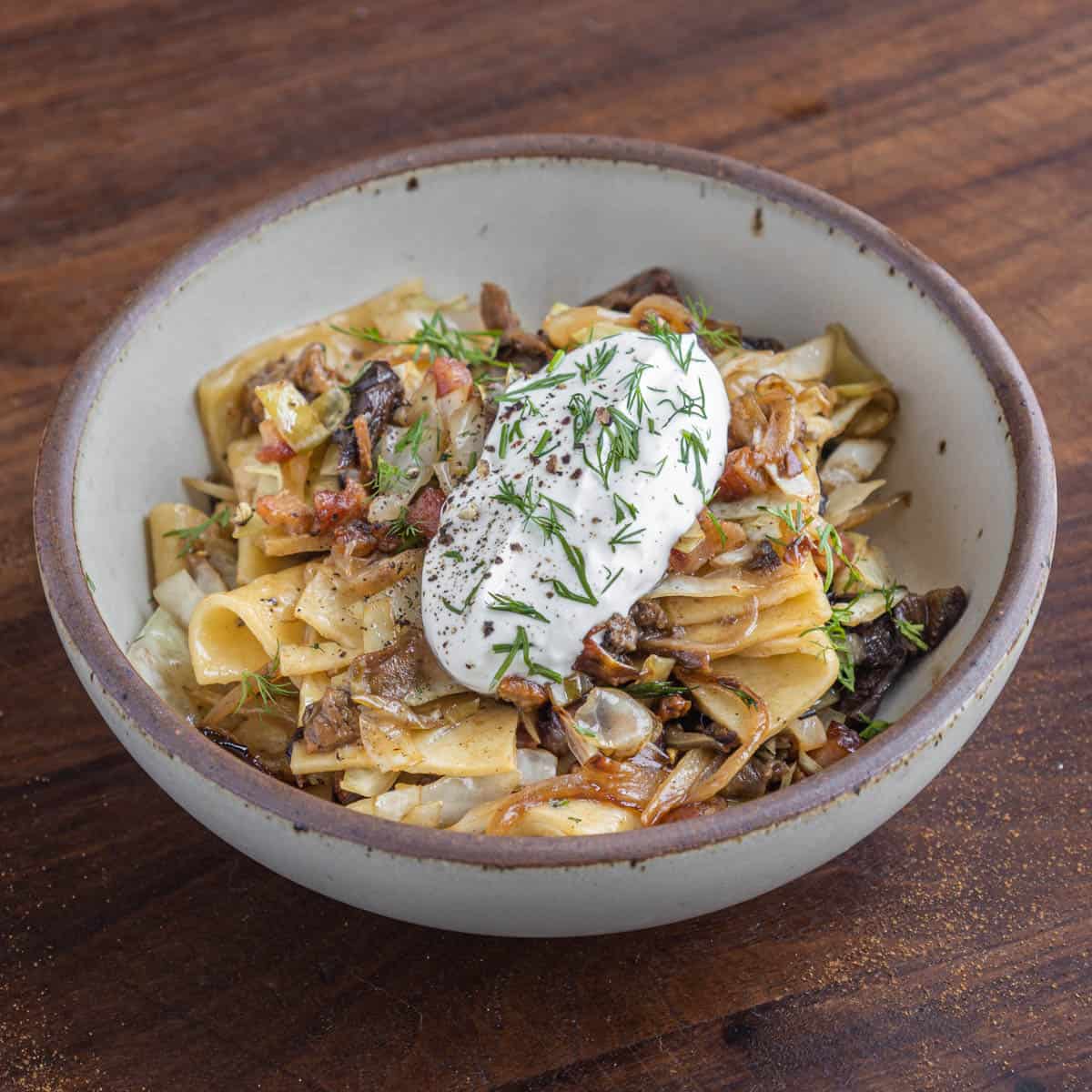
Sweet Lazanki
Likely a nod to Italian Renaissance cuisine, the pasta can be served sweet. Below it's tossed with a sauce of crushed black walnuts or almonds, poppy seeds, honey. Cooked fruits like cherries and plums can also be added.
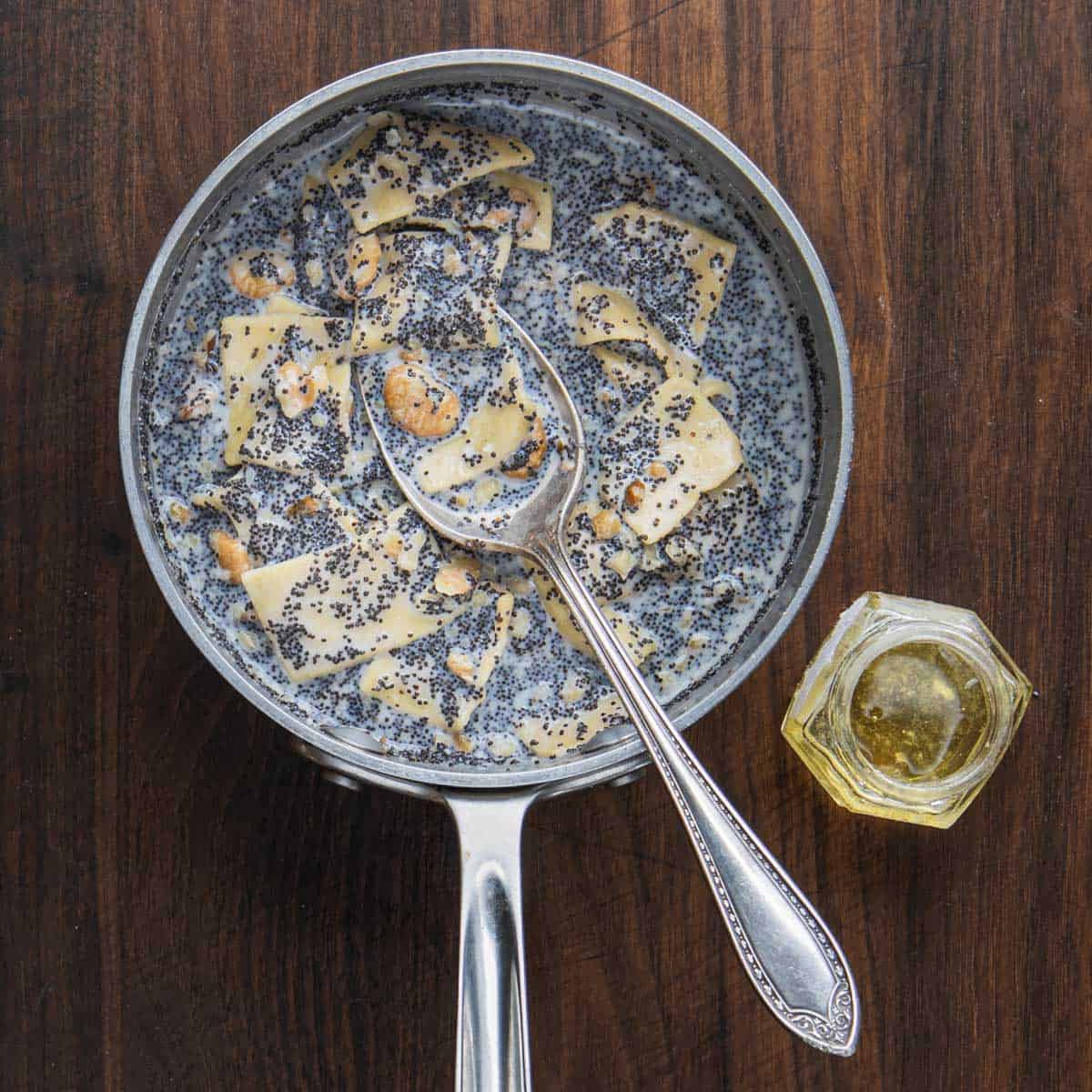
The version below uses fresh wild mushrooms, cabbage, and bacon. It's a crazy delicious bowl of comfort food to make again, and again.
Łazanki: Polish Pasta with Cabbage and Mushrooms
Equipment
- 1 12 inch cast iron skillet or large frying pan
- 1 3 quart soup pot
Ingredients
- 5 oz lazanki noodles or 5 oz dried egg noodles
- 6 oz fresh green cabbage cut into 1 inch julienne or half sauerkraut, half cabbage
- 8 oz bacon thinly sliced or polish sausage / kielbasa
- 4 oz wild mushrooms, especially porcini or honey mushrooms *see note on using dried mushrooms
- 6 oz (1 medium) white onion cut into 1 inch julienne
- 1 tablespoon chopped garlic
- 1 Tablespoons chopped fresh dill to taste
- ½ cup sour cream for serving (optional)
Instructions
- Bring a pot of water to a boil and season it lightly with salt (2 teaspoons per quart). Boil the cabbage for 1 minute, until tender crisp then remove and drain.
- In a wide pan render the bacon on medium-high heat until crisp. Drain off most of the fat and reserve for adding back to the dish.
- Add the onion to the bacon and stir, and add a splash of the reserved fat to the pan if needed. Cook for 5-6 minutes on medium high, stirring regularly, until the onion starts to brown on the edges.
- In a separate, smaller pan, cook the mushrooms in a splash of the bacon fat until wilted and starting to brown. Season with a pinch of salt.
- Add the cooked cabbage and mushrooms to the big pan with the onions. Cook on medium heat, stirring occasionally. Double check the seasoning for salt and pepper and adjust until it tastes good to you.
- Cook the pasta until al dente, stirring often. Remove the pasta and add to the pan. Immediately stir the pasta to incorporate and prevent it from sticking.
- Add the fresh dill and mix.
- Serve, sprinkle with chopped fresh dill, sour cream and plenty of fresh ground black pepper.
Video
Notes
Mushrooms
For the recipe pictured, I used fresh chicken of the woods and honey mushrooms (opieńka miodowa in Polish). Dried Polish mushrooms (borovik / porcini) are often added. Start with ½ oz of dried, rehydrated mushrooms, chopped and added after the onions. I do not add the mushroom liquid as this dish is fried, not stewed.Using Fresh Pasta
To make the dish with fresh pasta, substitute 6 oz fresh lazanki.Cabbage and Sauerkraut
You can use a mix of half sauerkraut half cabbage if you like.Nutrition
Resources
The information in this post was drawn from speaking with Polish friends in Poland, Ukraine, and friends with Polish Heritage in the U.S., as well as copies of the literature below.

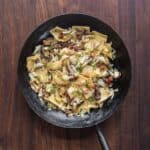
Caroline Sias
Thank you for this delicious recipe, I can't stop eating it!! I subbed the pasta for GF Banza chick pea pasta. Because of cholesterol I can't have bacon or sour cream. I subbed turkey bacon and non fat greek yogurt. Not quite the same but soooo good! I also used your suggestion to use some saurkraut which I think took it over the top of goodness, ha ha. This is definitely one of my favorite pasta dishes!
Alan Bergo
Hey thanks Caroline. Isn't it good?!
June Rempel
Delicious comfort food!! My Gram used to make this and I always wondered about it. Thank you so much for all of the extra info and ideas. I think she wuld love what you put together. I added sour cream since that's how she served it.
Bernard Schroeder
Great recipe and history! I made it with egg noodles as that is all that I could find. Do you have a source for the buckwheat lazanki noodles in the Midwest? I did find it online from a source in Texas, but the shipping was too expensive for me.
Alan Bergo
Glad it worked for you. Honestly, I liked my homemade noodles better than the ones I bought. But, I bought mine from Polka Deli They aren’t buckwheat though, just fyi
Gerri
Loved the story and history. Had tonight and added the sour cream and sourkraut. It makes it!
Alan Bergo
Thanks Gerri, glad it worked for you.
Shelly P.
Made this last night and it was huge hit. Great way to get the kids to eat sauerkraut!
Alan Bergo
I support that!
Josef
I used some shiitake and sauerkraut-half and half and this was very good.
Rik
I add sauerkraut.
Alan Bergo
Yes, If you want some, add some.
nicq
It's not "if you want some, add some".
Authentic łazanki recipe requires sauerkraut, not raw cabbage.
Also in my nearly 50 years of being an actual Polish person, I have never seen anyone actually Polish eat łazanki with sour cream.
Alan Bergo
Hey Nic, thanks for commenting. This post, and the research I did in the process speaking to friends from Poland and nearby countries is meant to help home cooks understand and bridge the gap between the ancestral dish, and the modern version influenced by convenience. Like language, cuisine evolves over time, and what constitutes the "true" version of anything is influenced by how people are making it now. For example, a friend of mine with Polish heritage in the U.S. doesn't make it with sauerkraut because her mother didn't, but they still use the traditional noodles, and they like to serve it with sour cream--are they wrong to call what they make łazanki? I don't think so.
With dishes that have so much history and variation, it's impossible to present a single version since the version people hold as "authentic" will be the one they were taught to make at home. While you may disagree with a few minor details here, it's important to take this article in context with other information online. Other articles on this topic will show a single recipe and no variations honoring the ancestral dish. Many of them don't even mention sauerkraut at all. They'll suggest you use commodity egg noodles or a pasta shape like rotini with no mention of the traditional łazanki shape, or instruct you use a can of button mushrooms instead of honey mushrooms or porcini-the heresy! 🙂
Gilbert
Ties in with pizzoccheri popular at ski resorts in former Savoya and Alta Valtellina/Sondrio regions. As I understand, pizzoccheri is buckwheat, buckwheat noodles, and the hearty dish made with them.
At first I thought the dark chewy flat pasta was some kind of beef jerky.
Pizzoccheri has buckwheat pasta, potatoes, Swiss chard or Savoy cabbage, lots of butter and some cheese. Several times ate it with a roasted bulb of fennel on the side.
Alan Bergo
Yes, absolutely. I actually demonstrated that dish years ago for a pasta class. I love the flavor of buckwheat. Haven't heard of the side of fennel before.